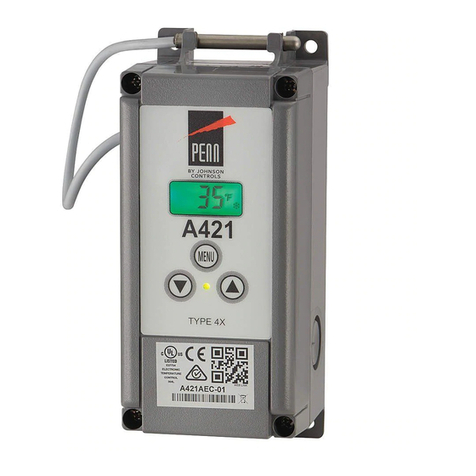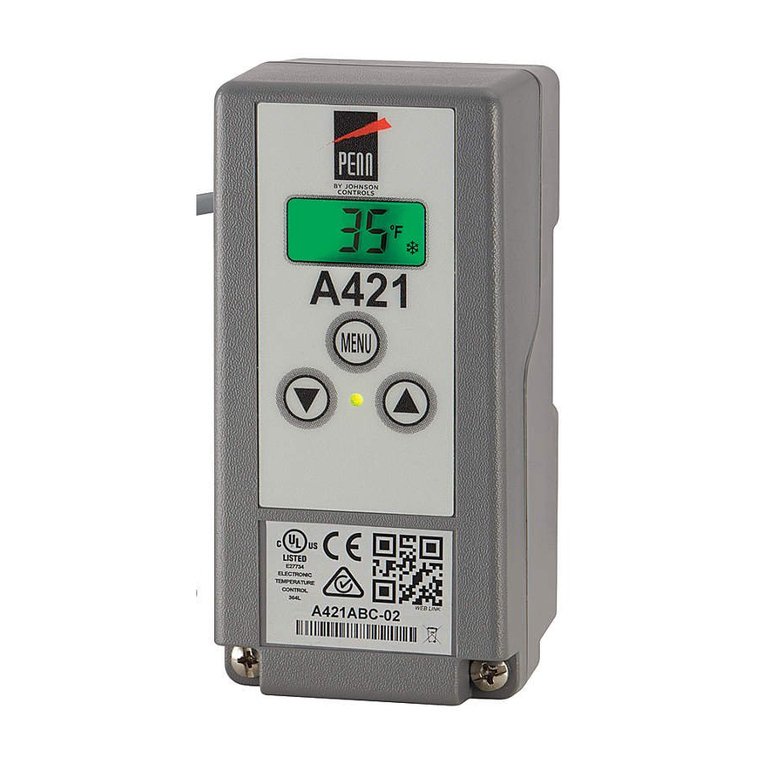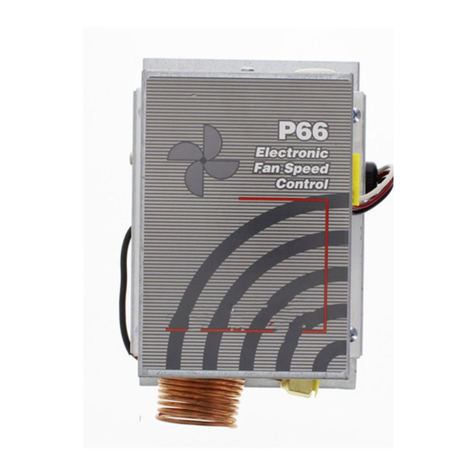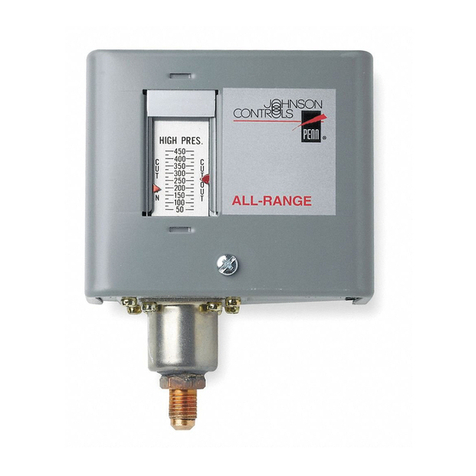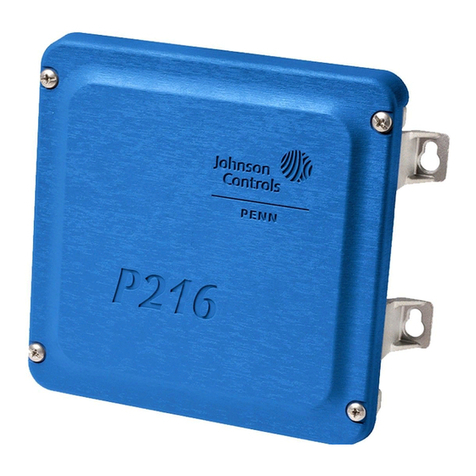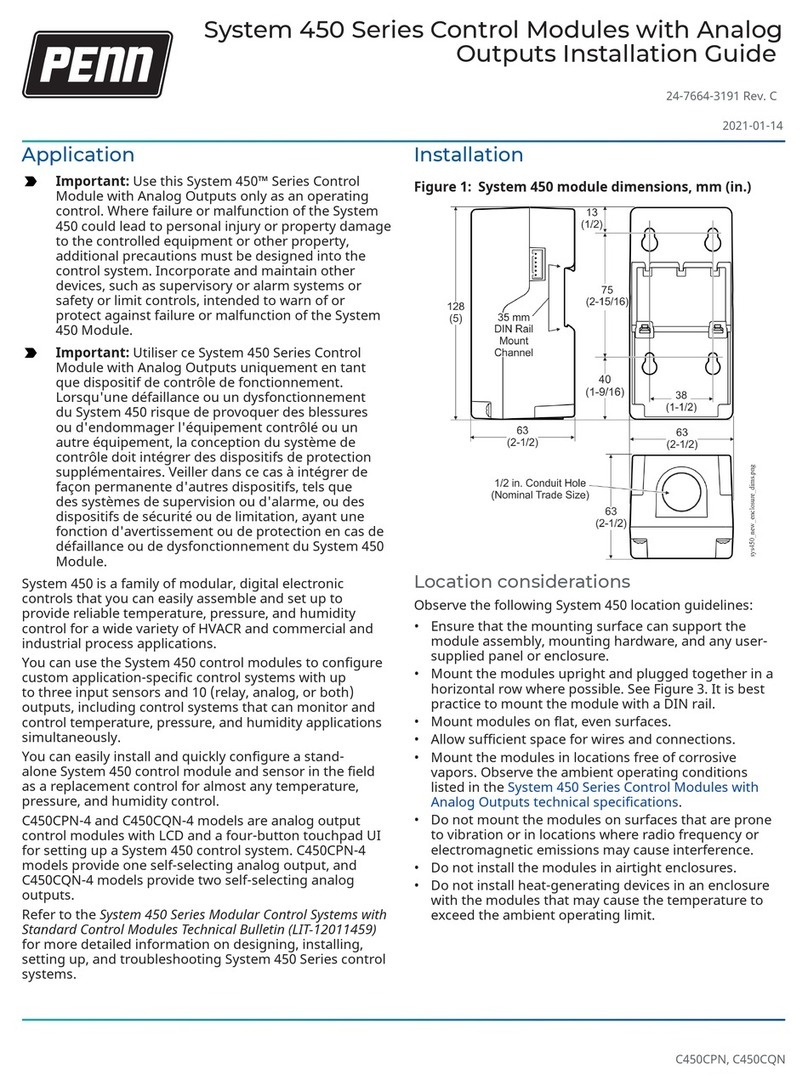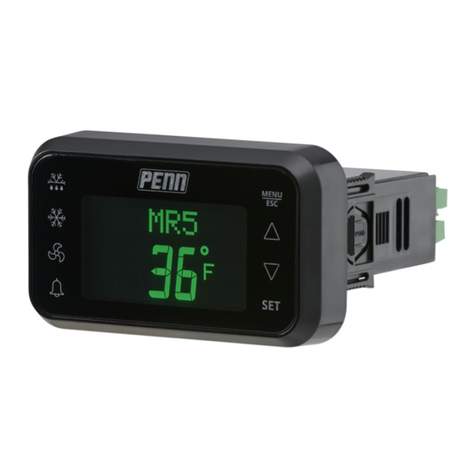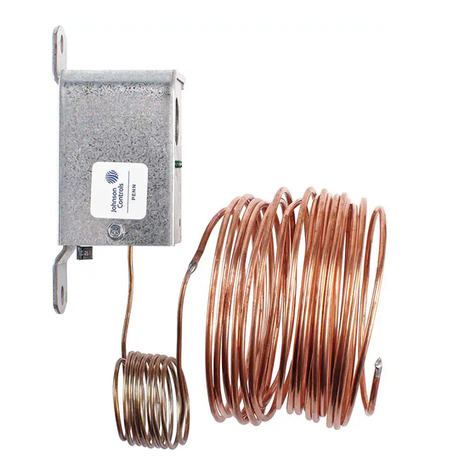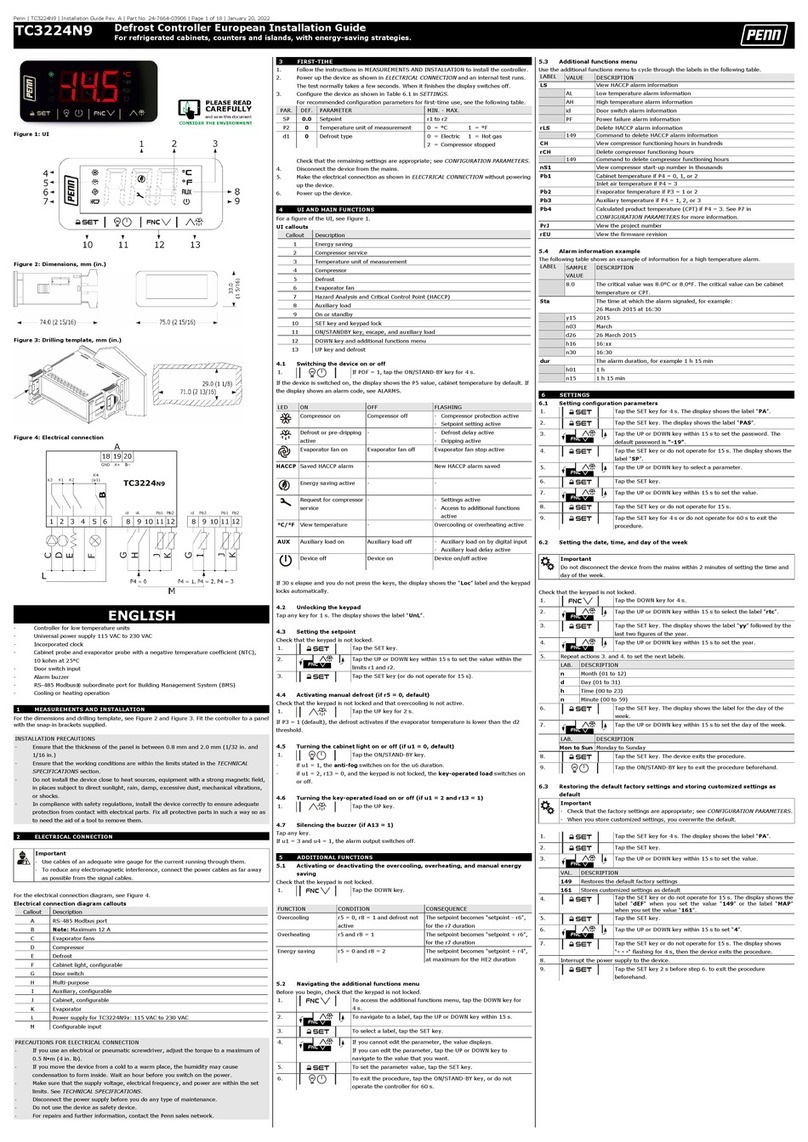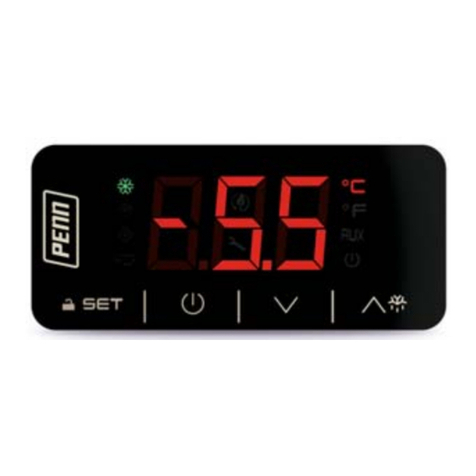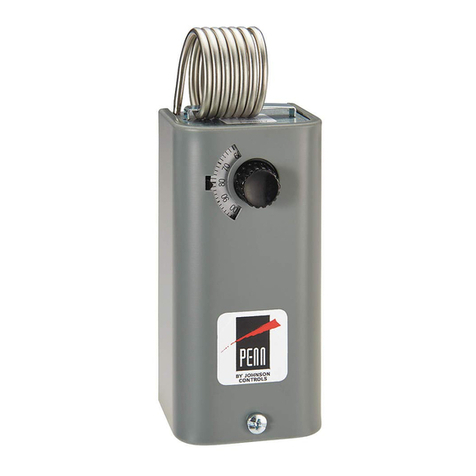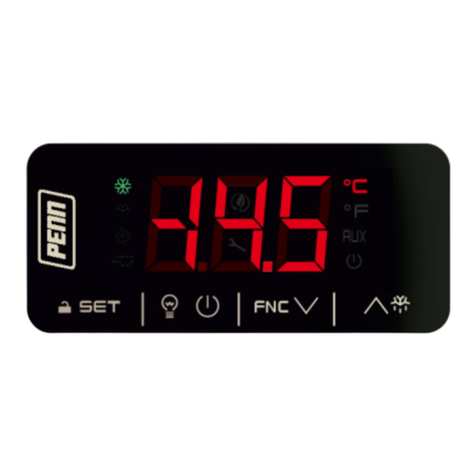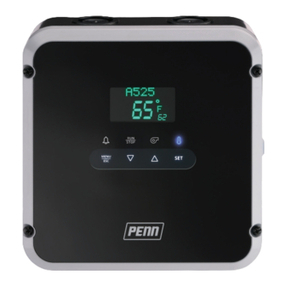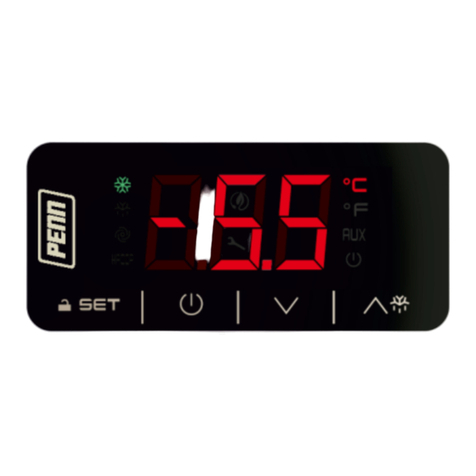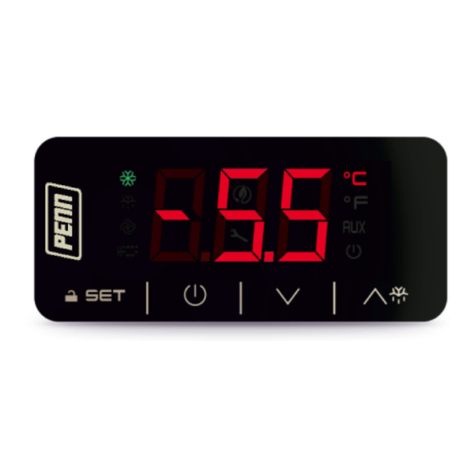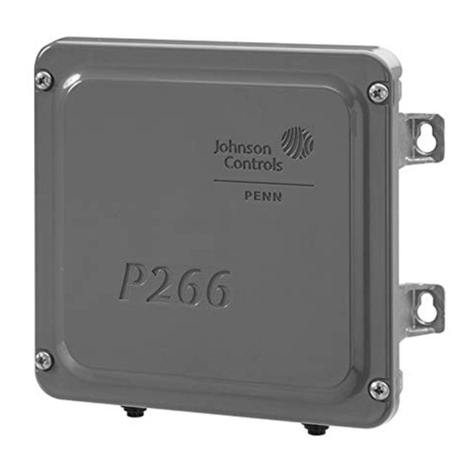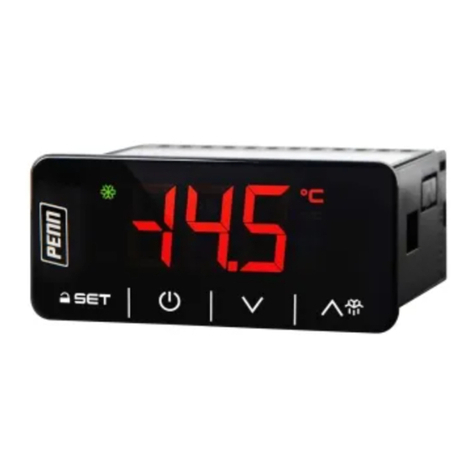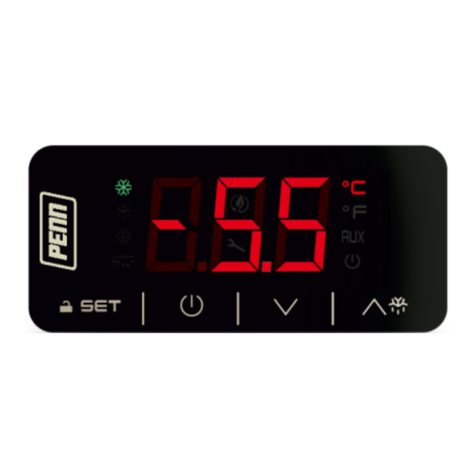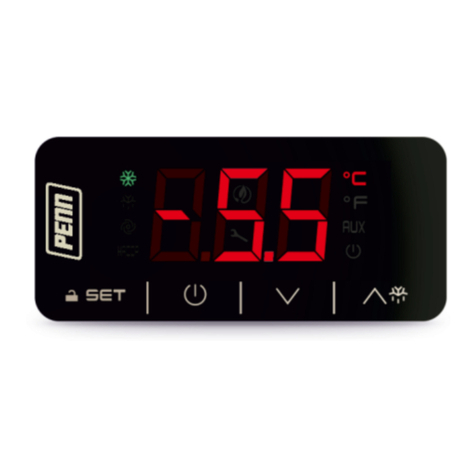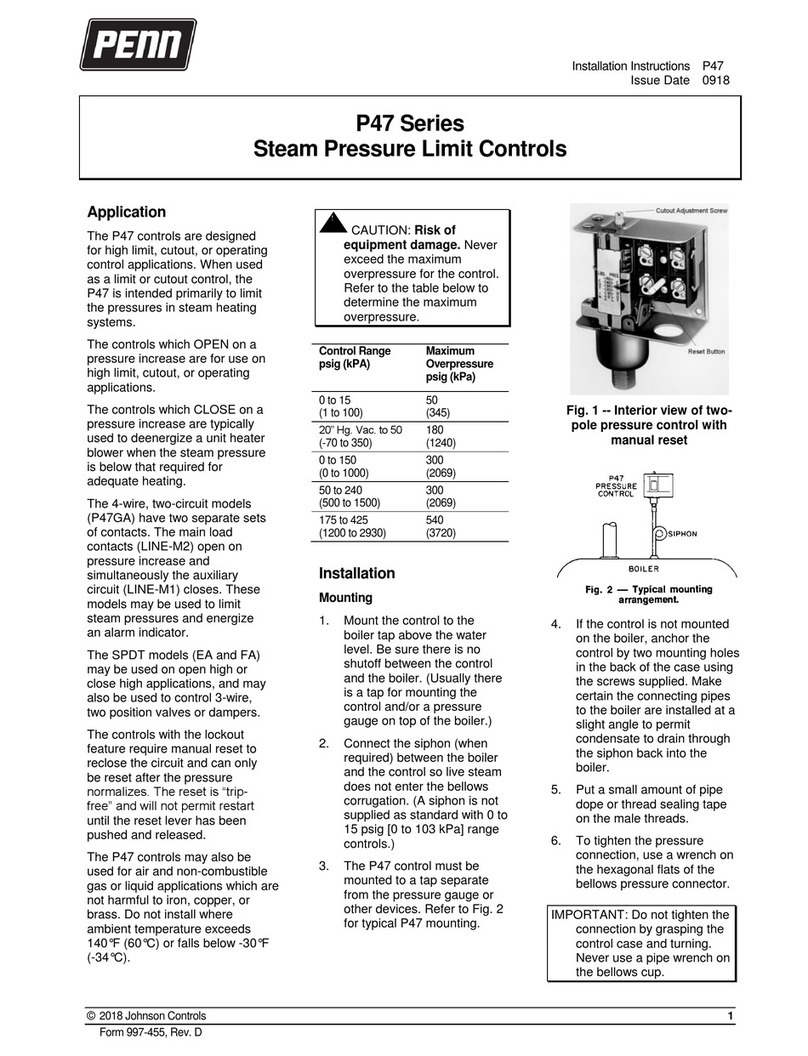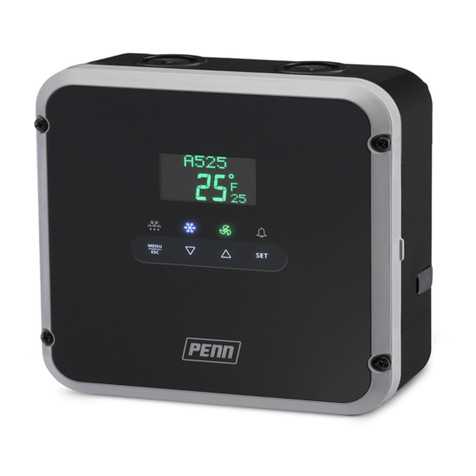
PENN | TC3B23N5V-004 | Installation Guide Rev. — | Part No. A163825YEM | Page 1 of 2 | 5September 2023
TC3B23N5V-004 Basic Defrost Controller Installation Guide
Basic controller for refrigerated cabinets with energy-saving strategies
- Controller for low temperature units
- Power supply of 115 VAC
- Cabinet probe and auxiliary probe, with negative temperature coefficient (NTC)
- Door switch or multi-purpose input
- Compressor relay with 16 A resistive load at 250 VAC
- Cooling or heating operation
Dimensions and installation
Installation precautions
-Ensure the panel’s thickness is between 1/32 in. and 1/16 in. (0.8 mm and 2.0 mm).
-Ensure that the working conditions are within the limits stated in Technical
specifications.
-Do not install the controller close to heat sources, equipment with a strong magnetic
field, in places subject to direct sunlight, rain, dampness, excessive dust, mechanical
vibrations, or shocks.
- Install the controller in compliance with safety regulations to ensure adequate
protection from contact with electrical parts. Fix all protective parts in such a way that
you need a tool to remove them.
Dimensions are in mm (in.). Fit the controller to a panel with the supplied snap-in brackets.
Important
-Use cables with an adequate cross section for the current that runs through them.
-Connect the power cables as far away as possible from the signal cables, to reduce
electromagnetic interference.
Wiring precautions
-If you use an electrical or pneumatic screwdriver, adjust the torque to a maximum of 4
in. lb (0.5 N•m).
-If you move the controller from a cold to a warm place, the humidity may cause
condensation to form inside. Wait an hour before you switch on the power.
-Make sure that the supply voltage, electrical frequency, and power are within the set
limits. See Technical specifications.
-Disconnect the power supply before you perform any type of maintenance.
-Do not use the controller as a safety device.
-For repairs and for further information, contact the PENN sales network.
Note: The default password for the controller is -19.
1.Install the controller in the panel. See Dimensions and installation.
2. Wire power to the controller. See the power supply terminal in Wiring.
3. Tap On/Standby to turn on the controller. An internal test runs for several seconds.
After the internal test, the display switches off.
4. Configure the controller. See Setting configuration parameters in Settings. The
following list contains some useful parameters to configure for first time setup:
-Setpoint (SP), default: 32
-Temperature unit of measurement (P2), default: °F
-Defrost type (d1), default: electric
Note: Check that the remaining settings are also appropriate. See Configuration
parameters.
5. Disconnect the controller from the power supply.
6. Make the electrical connectionswithout powering up the controller. See Wiring.
7. Reconnect the power supply.
8. Tap On/Standby to turn on the controller.
User interface and main functions
Switching the controller on or off
If POF is set to 1, tap the On/Standby key for 4 s. See Setting
configuration parameters.
When the controller is switched on, the display shows the value that the parameter P5
indicates. P5 is set to cabinet temperature by default. If the display shows an alarm code, see
Alarms.
Compressor on Compressor off - Compressor protection active
- Setpoint setting active
Defrost or pre-dripping active — - Defrost delay active
Evaporator fan on Evaporator fan off Evaporator fan stop active
- If the controller is on,
energy saving active
- If the controller is off, low
— —
Controller off Controller on Controller on/off active
Key Key function
SET
On/Standby
Up or Defrost
Function or Down
If you do not press a key for 30 s, the screen displays Loc and the keypad locks automatically.
Unlocking the keypad
Tap a key for 1 s. The screen displays UnL. Unlock the keypad before you complete any task. If
a password is set, complete the following steps:
1. If a password is set, tap the Up or Down key within 15 s to select the password.
See Setting a password.
2. Press the SET key.
Setting the setpoint
1. Tap the SET key.
2. Tap the Up or Down key within 15 s to set the value within the limits r1 and r2.
See Configuration parameters.
3. Tap the SET key or do not press a key on the keypad for 15 s.
Activating manual defrost
1. Check that parameter r5 is set to 0 for cooling. r5 is set to 0 by default. See
Setting configuration parameters.
2. Press the Up or Defrost key for 2 s.
Note: If P4 is set to 1, defrost only activates if the evaporator temperature is lower than the
d2 threshold. P4 is set to 1 by default.
Switching the cabinet light on and off
You can switch the K2 relay on or off if you configure and wire it for a cabinet light or a button-
operated load.
1. Check that parameter u0 is set to 3 for cabinet light, or 1 for button-operated
load. u0 is set to 3 by default. See Setting configuration parameters.
2. Tap the On/Standby key..
Note: The button-operated load does not switch on or off if the keypad is locked.
Viewing or deleting compressor functioning hours
1. Press the Function or Down key for 4 s.
2. Tap the Up or Down key within 15 s to select a label.
View compressor functioning hours, in hundreds
Delete compressor functioning hours
3. Tap the SET key.
4. If you selected rCH, tap the Up or Down key to set 149.
5.Tap the SET key.
6. To exit the procedure, tap the On/Standby key, or do not press a key on the
keypad for 60 s.
Viewing the temperature detected by the probes
1. Press the Function or Down key for 4 s.
2. Tap the Up or Down key within 15 s to select a label.
3. Tap the SET key.
4. To exit the procedure, tap the On/Standby key, or do not press a key on the
keypad for 60 s.
Setting a password
1. Press the SET key for 4 s. The screen displays PA.
2. When PA displays, tap the SET key.
3. Tap the Up or Down key within 15 s to select the password (PAS) value that you
want. The default password is -19.
4. Tap the SET key.
Setting configuration parameters
1. After you unlock the keypad, tap the SET key. The screen displays SP.
2. Tap the Up or Down key to select a parameter.
3. Tap the SET key.
4. Tap the Up or Down key within 15 s to set the value.
5. Tap the SET key.
6. Tap the SET key for 4 s or do not press a key on the keypad for 60 s to exit the
procedure.
Restoring the defaults, and storing customized default settings
Important
-Check that the factory settings are appropriate. See Configuration parameters.
-If you store customized default settings, you overwrite the factory defaults.
Before you begin, if you want customized defaults, set the controller parameters to the values
that you want as defaults.
1. After you unlock the keypad, press the SET key for 4 s. The screen displays PA.
2. When PA displays, tap the SET key.
3. Tap the Up or Down key within 15 s to set the value.
Value to restore the defaults
Value to store your customized settings as the defaults
4. Tap the SET key. For restoring the defaults, the screen displays dEF. For storing
customized defaults, the screen displays MAP.
5. Tap the SET key.
6. Tap the Up or Down key within 15 s to select the value 4.
7. Tap the SET key. The screen flashes with - - - for 4 s. After this, the controller
exits the procedure.
8. Interrupt the power supply to the controller. This saves your changes.
Note: To exit the procedure without making a change, press the SET key for 2 s before you
select the value 4.
P2 1 Temperature unit of
0 = °C 1 = °F
P4 1 Auxiliary probe function 0 = Disabled
1 = Evaporator probe for
defrost and fan
2 = Evaporator probe for fan
P5 0 Value displayed 0 = Cabinet temperature
1 = Setpoint
2 = Auxiliary temperature
r4 0 Setpoint offset in Energy saving
0°F/°C to 99°F/°C
r5 0 Cooling or heating operation 0 = Cooling
r12 0 Position of the r0 differential 0 = Asymmetric
C0 0 Compressor on delay after
0 min to 240 min
Compressor off minimum time
Compressor on minimum time
C4 10 Compressor off time during
0 min to 240 min
C5 10 Compressor on time during
0 min to 240 min
C6 176 Threshold for high condensation
0°F/°C to 199°F/°C
C7 194 Threshold for high condensation
0°F/°C to 199°F/°C
High condensation alarm delay
Defrost, if r5 is set to cooling
d0 8 Automatic defrost interval
Note: If d8 is set to 3, the
automatic defrost interval is
0 h to 99 h
0 = Only manual
d1 0 Defrost type 0 = Electric
1 = Hot gas
Threshold for defrost end
Enable defrost at power-on
Defrost delay after power-on
d6 2 Value displayed during defrost 0 = Cabinet temperature
1 = Display locked
d8 0 Defrost interval counting mode 0 = Controller on hours
1 = Compressor on hours
2 = Hours with evaporator
temperature < d9
d9 0 Evaporation threshold for
automatic defrost interval
-99°F/°C to 99°F/°C
Enable defrost timeout alarm
d15 0 Consecutive time with
compressor on for hot gas
0 min to 99 min
d18 40 Adaptive defrost interval
Note: If compressor on and
evaporator temperature < d22
0 min to 999 min
0 = Only manual
d19 3 Threshold for adaptive defrost
Note: Relative to the
automatically calculated optimal
evaporation temperature
(Optimal evaporation
0°F/°C to 40°F/°C
d20 180 Consecutive time with
compressor on for defrost
0 min to 999 min
d22 2 Evaporation threshold for
adaptive defrost interval
counting Note: Relative to the
automatically calculated optimal
evaporation temperature
(Optimal evaporation
0°F/°C to 19°F/°C
A1 -20Threshold for low temperature
alarm
Note: Relative to setpoint (SP -
0°F/°C to 99°F/°C
0 = Disabled
A4 20Threshold for high temperature
alarm
Note: Relative to setpoint (SP +
0°F/°C to 99°F/°C
0 = Disabled
A6 12 High temperature alarm delay
0 min×10 to 99 min×10
A7 15 High and low temperature alarm
0 min to 240 min
A8 15 High temperature alarm delay
0 min to 240 min
A9 15 High temperature alarm delay
0 min to 240 min
A11 2 Reset differential for high and
1°F/°C to 15°F/°C
F0 3 Evaporator fan mode during
normal operation
0 = Off 1 = On
2 = On ifcompressor on
3 = Thermoregulated, with
F1
4 = Thermoregulated, with
F1, if compressor on
F1 30 Threshold for evaporator fan
-99°F/°C to 99°F/°C
Evaporator fan mode during
defrost and dripping
2 = According to F0
F3 2 Maximum evaporator fan off
0 min to 15 min
F4
Evaporator fan off time during
0 s×10 to 240 s×10
F5 10 Evaporator fan on time during
0 s×10 to 240 s×10
